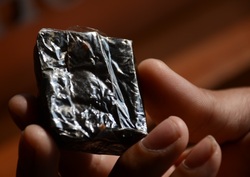
At the CITES meeting in Bangkok I attended a press conference where the South African minister for the environment announced that South Africa had tried a wide range of measures to curtail rhino poaching, but she confirmed that so far they had failed and it was now time to look at the option of legalizing the trade.
Having visited ranches in South Africa with very happy live rhinos enjoying what to me looked like a good quality of life – and being alive - made for a pretty convincing argument that having a dehorned rhino grazing or browsing with its calf is a better option than an orphaned calf trying to suckle on its slaughtered mother.
However, on my last trip to Laos and Vietnam in October this year I once again investigated the tiger bone trade a TCM product in the same league as rhino horn. I found a situation that might have relevance when discussing the proposed legalizing of the rhino horn trade.
But first, a bit more background on the tiger bone/cake trade and demand which is most pronounced in Vietnam with tiger wine being the equivalent in China.
In 2010 a group of Vietnamese journalists managed to get into one of the biggest tiger farms in Laos. They reported in their story that a tiger carcass was selling for U$ 140 a kg. The buyers, usually from China or Vietnam, chose a live tiger and then pay per kg after the cat has been shot or electrocuted, with 7-10 kg deducted from the weight for the intestines. The price in 2010 per kg was a little more than the quoted U$ 140 per kg for cats above 100 kgs, a little less for tigers below that.
In October this year, a Swiss print journalist and myself managed to get a Vietnamese investigator to visit the same farm and film with a hidden camera. In 2010 the Vietnamese writers mentioned a stock of 100 tigers, now the farm has over 300, plus some bears and clouded leopards. The farm is also being expanded to hold about 700 tigers. This will be achieved with breeding and imports of other captive borne tigers mostly from Thailand and Malaysia . Plus there are new such farms being set up. All of this is illegal under CITES resolution (14.69) passed in 2012 and stating:
“Parties (to the convention) with intensive operations breeding tigers on a commercial scale shall implement measures to restrict captive populations to a level supportive ONLY FOR CONSERVING WILD TIGERS. Tigers should not be bred for their parts or derivatives.”
There is no explanation how tiger farming in any form will support the conservation of wild tigers since they cannot be reintroduced into the wild and while commercial captive breeding might be viewed as having the potential of satisfying demand and bringing down prices and as such taking the pressure of the wild populations. However that seems not to be what is advocated with the above notification.
Plus, as with other such regulations the above is totally ignored in countries like Laos where national laws do not seem to apply to rich foreign investors. The CITES enforcement regime would allow a country like Laos to be suspended with all legal aspects of the trade having to stop but that is a last step measure as far as CITES is concerned. The policy seems to have more member states irrespective of their ability and willingness to comply with the convention.
The breeding is obviously commercial, which appears to be legal in Laos and the cats are pumped full of antibiotics with a weekly injections due to past outbreaks of epidemics which killed a lot of tigers in many of the farms which in some cases also impacted farm workers. The estimates are that the above mentioned farm alone sells several hundred tigers a year to be turned into TCM.
Plus there are the imports of lion bones and skeletons from South Africa which are then also sold as “tiger bone” to be turned into tiger wine (China) or tiger bone cake (Vietnam). We are talking of several hundred skeletons being exported and imported on an annual basis and being told of a 3 ton shipment about to arrive (CITES trade statistics show the export of 101 full skeletons in 2010 which increased to over 500 in 2011 with no figures available yet for 2012) . When comparing prices between Hanoi, the Laos and Vietnam border and the ones quoted by the journalist team in 2010 the per kg rate now averages out at U$ 200. A 30% increase in three years despite the drastic increase in supply.
If we then put that in context with the estimate of some 3000 tigers remaining in the wild and only a handful left in a country like Laos, the message is that prices are still going up and more so for wild tigers (a wild tiger can be identified by the color and damage to its canines, while a captive tiger has snow white teeth with no crack or breaks, as they are fed on chickens ). The poacher today also gets more per kilo then he did three years ago and while it might be a fraction of the sales price of some U$ 25 000 per carcass it is still more than enough for qualified tiger poachers to spread out from countries like Vietnam to far off destinations in Malaysia and Myanmar to get hold of some of the last wild tigers.
The question arises would the same demand supply scenario play out if the market was supplied with stocks of legal rhino horn?
One thing which has not happened, on the back of the additional supply from captive farming and the introduction of imported lion skeletons, which by now far exceeds the supply from the remaining wild population, is that the overall price has come down with the incentives for poachers decreasing which is clearly one of the main objectives in discussing the possibility of legalizing the rhino horn trade. There are a lot more tigers today in many of the countries concerned but it involves tigers in a small cages about to be electrocuted at the request of a Chinese or Vietnamese buyer. Is this the kind of flagship symbol the world wants to see preserved?
Is this an aspect of the demand and supply characteristics which should be studied in more detail and be analyzed as a model for what might happen – on a much larger scale – if the rhino horn trade was legalized?
